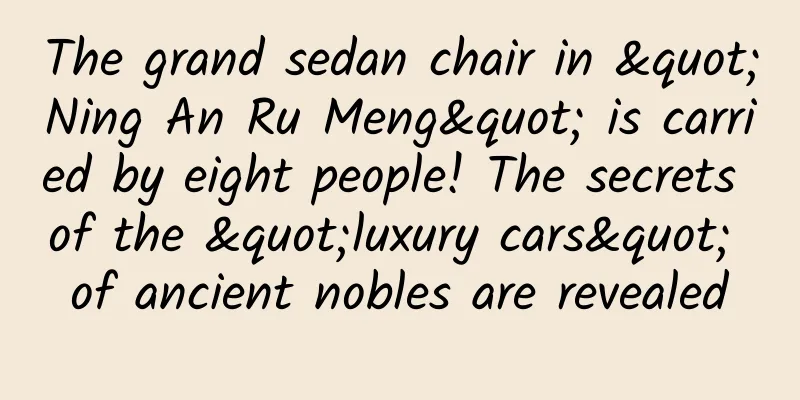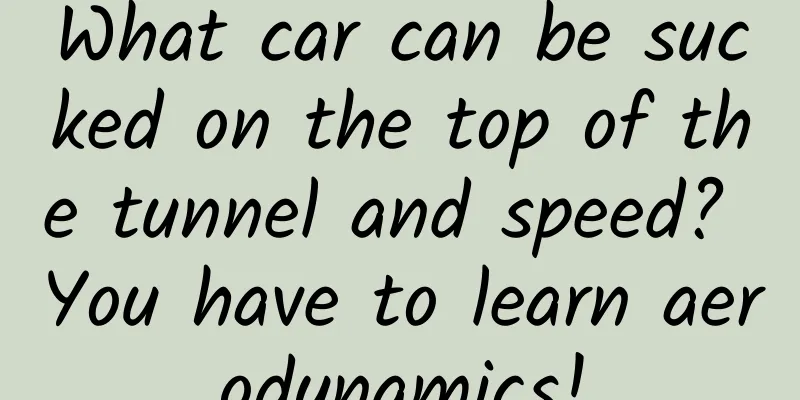The grand sedan chair in "Ning An Ru Meng" is carried by eight people! The secrets of the "luxury cars" of ancient nobles are revealed

|
Fan-shot stills of the drama "Ning An Ru Meng" were leaked online. The heroine Jiang Xue Ning rode in an "eight-man sedan chair" in a domineering manner. Netizens could not help but sigh: Queen Ning is as imposing as a rainbow. What kind of transportation did the ancient nobles take? The words we can search for are: yu, jiao, chariot, che... It can be said that the confusion of "words" is gradually confusing. In fact, it can be roughly divided according to two standards: with wheels or without wheels, and relying on human power or animal power to move. Let's take a look. 【Tips】 Some scholars believe that "Yu" was a general term for vehicles in the early days, and later gradually referred to wheelless vehicles, which could also be called "Nian" without wheels. Of course, in the later period, wheeled vehicles or niang were also called "Yu". These words have long been difficult to distinguish in the evolution of their meanings. We can use them flexibly according to the situation. See watermark for source 01 What are the human tools? There are two types of carriages: walking carriages and carrying carriages . The difference is that carrying carriages do not have a fixed place for "passengers" to put their feet, so they are more casual, while walking carriages are relatively sophisticated, with a special place for "passengers" to put their feet. Among them, the sedan chair can be further divided into shoulder sedan chair, waist sedan chair , etc. According to the position of the person who lifts the sedan chair, it can be divided into shoulder sedan chair, waist sedan chair, etc. As the name suggests, the sedan chair lifted by the shoulders is called "shoulder sedan chair", and the sedan chair lifted by the hands and only up to the waist is called "waist sedan chair". There are many examples of famous historical figures riding in sedan chairs in cultural relics, such as Emperor Cheng of Han in "The Admonitions of Court Instructress to the Emperor" and Emperor Taizong of Tang in "The Procession of Emperor Taizong of Tang to the Buddhist Monastery". Scene 5 of the Admonitions of the Court Ladies by Gu Kaizhi of the Eastern Jin Dynasty: Ban Jieyu Refuses to Ride the Palanquin, depicts Emperor Cheng of Han traveling with Ban Jieyu. Emperor Cheng of Han wanted to ride in the same chariot with Ban Jieyu, but Ban Jieyu refused. From the painting, we can see that six people carried the chariot on their shoulders, which means that Emperor Cheng of Han rode on a "shoulder sedan chair". The mural in the tomb of Sima Jinlong, the Prince of Langya in the Northern Wei Dynasty, also shows the scene of "Ban Jieyu Saying Goodbye to the Seal". In the 1960s, archaeologists excavated Sima Jinlong's tomb and found that the difference between this mural and the "Biography of Female Historians" is that there are no other concubines sitting next to Emperor Cheng of Han, and the number of people carrying the sedan chair has changed to four... The "Burenian Tu" painted by Yan Liben in the Tang Dynasty depicts the scene of Songtsen Gampo sending envoys to meet Emperor Taizong of Tang in the 14th year of Zhenguan (640 AD). From the painting, we can see that in addition to the three people holding umbrellas and fans, there are six women carrying the sedan chair with their hands, which shows that the sedan chair that Emperor Taizong of Tang rode on should be a "waist sedan chair". As for the number of bearers, the most common ones are 4, 6, or 8. The so-called eight-bearer "big" sedan chair (the difference between sedan chairs will be discussed separately later) is considered to be of higher specifications when 8 bearers are involved. 02 Elephants can also pull "carts" The means of transportation used by the ancient nobles did not necessarily have to rely on human power, but could also rely on other animals, such as cows, horses, or even elephants to pull or carry them. If animals were to pull (that is, pull), the means of transportation would need to have wheels! Ox-drawn and horse-drawn chariots existed in the Northern Wei Dynasty. The Book of Wei also described their uses and regulations: the emperor rode in a horse-drawn chariot when he went to the fields or made small sacrifices; the emperor, the empress dowager, and the grand empress dowager rode in an ox-drawn chariot when he went to suburban temples, which was pulled by 12 oxen. The elephant chariot is a unique animal-powered means of transportation. There are many murals depicting elephant chariots in the Mogao Grottoes in Dunhuang, spanning the period from the Southern and Northern Dynasties to the Five Dynasties. The left picture shows the mural on the south slope of the ceiling of Cave 296 in Mogao Grottoes, dating back to the Northern Zhou Dynasty; the right picture shows the mural on the south wall of Cave 61, dating back to the Five Dynasties period. Both murals show the scene of "carrying a chariot with an elephant" Although the elephant carriage is eye-opening, its contents mostly show Buddhist scenes, which does not match the "passenger" mentioned in this article. But it doesn't matter, elephants can not only "carry" but also "pull", and there will be real examples of "elephant-pulled transportation" later. 03 The peak of “face”: Qing Dynasty The wheeled vehicles used by ancient nobles had reached their peak of "prestige" by the Qing Dynasty, especially the "Five Chariots" (also known as the "Five Chariots"), which were modified in the eighth year of Emperor Qianlong's reign (1743) for use by the Qing emperors. The "Five Chariots" were: the Jade Chariot, the Golden Chariot, the Elephant Chariot, the Leather Chariot, and the Wooden Chariot. Jade Chariot: It is named after the round jade plate inlaid on its top. There is one elephant and two horses. The cover on the top and the two flags behind the chariot are both blue. It is the highest specification among the five chariots. Golden Chariot: It is named after the round gold plate inlaid on its chariot top. It has one elephant and two horses. The cover on the chariot top and the two flags behind the chariot are bright yellow. Its specifications are second only to the Jade Chariot. Xianglu: It is named after the round ivory plate inlaid on the top of the chariot. It has four serving horses and six riding horses. The cover on the top of the chariot and the two flags behind the chariot are both red. Wooden carriage: It is named after the yellow pear flower wood round plate on the top of the carriage. There are two serving horses and four riding horses. The cover on the top of the carriage and the two flags behind the carriage are all black. The leather carriage is named after the leather covering its roof. It has one serving horse and three riding horses. The cover on the top of the carriage and the two flags behind it are decorated with gold. The Jade Chariot and the Golden Chariot among the Five Chariots of the Qing Emperors are essentially "elephant-pulled vehicles", which are much more powerful than being pulled by cows or horses! Of course, the Five Chariots were not used casually. They were only used when the Qing emperor attended important ceremonies, court meetings, or inspections . You may have heard an aunt in a drama say: "There are only three proper masters in the Forbidden City: the emperor, the empress dowager and the empress." That being said, the transportation of the empress dowager and the empress is quite different from that of the emperor. In the early Qing Dynasty, the vehicles used by the empress and the empress dowager were called "Yu". In the 14th year of Emperor Qianlong's reign (1749), the name was changed to "Che". All concubines below the empress were treated like this. This time, the name lost its status as a top-notch vehicle. In addition, the concubines' carriages did not have elephants like the "Lu" used by the emperor. They could only be driven by horses, and the number of horses was strictly controlled, only one could be used. 04 A sedan chair popular among the nobility and common people You may have noticed that the cars, chariots and sedan chairs of the Qing Dynasty have all become "small houses". If people sit in them, they will definitely not be able to see anything. Why weren't the sedan chairs and chariots of the Han and Tang Dynasties surrounded by fences? In fact, this type of transportation with enclosed space had already appeared at the latest in the Tang Dynasty. This mural is from Cave No. 156 of the Mogao Grottoes in Dunhuang. It depicts a scene of carrying a sedan chair. From the painting, we can see that the sedan chair is in the shape of a pavilion and is carried on the shoulders of eight people. Cave No. 156 is also known as Zhang Yichao Cave. It was built during the Xiantong period of the Tang Dynasty. It was built by Zhang Huaishen, the nephew of Zhang Yichao, the governor of the eleven states of Hexi, in the name of his merits. It is a representative of the late Tang Dynasty grottoes. We will find that this "chariot" is designed in the shape of a pavilion, and its enclosedness is much stronger than the "chariot" ridden by Emperor Taizong of Tang. In addition to the example of Cave 156 in Mogao Grottoes, there is also a mural in Cave 156 titled "A Journey of Lady Song from Henei County of the State of Song". In the mural, the "separator" is surrounded by curtains made of gauze, which hang down to form a relatively closed space. The sedan chair in the middle of the painting Lady Song from Henei County, Song State, has curtains around it. You will also find that although it is carried by human power, it has "melon-eating wheels", indicating that human-powered sedan chairs may also have symbolic wheels. In the Song Dynasty, this closed design became more and more popular. This kind of means of transportation was commonly called "sedan". It has a roof, a closed cabin, a door, and small windows on both sides. From the famous work "Along the River During the Qingming Festival" by the great Northern Song Dynasty painter Zhang Zeduan, we can see that this closed so-called "sedan" means of transportation has matured in form. The sedan chair in the painting Along the River During the Qingming Festival by Zhang Zeduan of the Northern Song Dynasty (partial) This closed vehicle, which could rely on both human and animal power, became popular in later generations, from the royal family (such as the five sedan chairs of the Qing emperors mentioned above) to the common people (such as the sedan chair for weddings). 05 A sedan chair with 8 bearers? Or a sedan chair with 16 bearers? When it comes to carrying a sedan chair, we have to mention the number of bearers. This is an interesting topic. We often say that a sedan chair with eight bearers is very impressive, but in the late feudal society with a strict hierarchy, not everyone could ride in a sedan chair with eight bearers. Take the Qing Dynasty, where the etiquette system was relatively complete, for example: eight bearers was not the upper limit, and there were also sedan chairs with sixteen bearers! Data source: History of Qing Dynasty: Records of Vehicles and Clothing [Fun Extension] 32 The truth about carrying a sedan chair Wang Shizhen, Jiao Hong and other scholars of the Ming Dynasty who were contemporaries of Zhang Juzheng believed that Zhang Juzheng, the powerful prime minister in the early Wanli period, had ridden in a sedan chair carried by 32 people. However, some later scholars believed that this was a smear campaign by Zhang Juzheng's "political enemies" against him. The "History of Ming Dynasty: Records of Clothing" clearly stipulates that officials of the third rank and above in the Ming Dynasty could ride in sedan chairs, but the number of sedan bearers could not exceed 4. This is the truth about ancient "luxury cars". How do they compare with today's luxury cars? References: Wu Tufa. A Brief Discussion on Chariots and Vehicles in the Pre-Qin Period[J]. Zhejiang Social Sciences, 1997(04):103-106 Yan Yan. Explanation of “Nian”, “Yu” and others[J]. Art Hundreds, 2010, 26(02): 185-188+184 Ji Guohuang. The rise and fall of the traditional means of transportation - the sedan chair[J]. Traffic and Transportation, 1995(01):39-40 Zhong Yan. Study on the Image of Elephant and Vehicle in the Mogao Grottoes Murals[J]. Chinese Art Research, 2020(01):52-58 Shu Xiaping. Research on the Royal Guards of the Qing Dynasty[D]. Suzhou University, 2011. The author of this article is Qu Shiyi, a master of history from Wuhan University. Shang and Zhou dynasty archaeology direction. END Tadpole Musical Notation original article, please indicate the source when reprinting Editor/Heart and Paper |
<<: "This time, Chinese astronauts may plant several crops of rice in space"
>>: How did the Earth survive? Scientists have found new clues
Recommend
Double Eleven e-commerce advertising case!
On the one hand, competition for traffic is inten...
80% of PS4 players have never seen Drake? Game experience of "Uncharted: Drake Collection"
Since Sony officially announced "Uncharted 4...
iOS 11's 6 major App Store upgrades, are developers ready?
iOS 11 eliminates all non-64-bit chip devices, wh...
How can educational institutions integrate private domain traffic operations into their business?
The concept of private domain traffic emerged in ...
As online music competition intensifies, Baidu may be forced to withdraw
This is destined to be a turbulent year for the o...
How to distribute mini programs? What are the advantages of mini program distribution?
With the innovative development of wireless Inter...
Breaking news: a 61-year-old mother suffering from hypertension died suddenly on the plane. These 4 types of people should be especially careful when flying!
Airplane travel has become a part of modern life....
There are certain requirements for underwear fabrics. Which one is the true love of your butt?
Just as "there are a thousand Hamlets in the...
What kind of data analysis should be done from the start-up to the maturity of APP?
DAU, MAU, retention rate , frequency, duration......
How much does it cost to attract investment for the Linfen Fruit Mini Program? What is the investment price for Linfen Fruit Mini Program?
Linfen Fruit Mini Program investment promotion is...
What? Asteroids also have osteoporosis?
As people age, if they do not pay attention to ca...
How to make users fall in love with watching ads?
No one likes to watch ads, but everyone needs to ...
Zhihu operation and promotion strategy
I am currently researching how to create Zhihu. I...
Is the “Japanese original hydrogen cup” priced at thousands of yuan just a waste of money?
Rumor: "Hydrogen cups can produce hydrogen w...
Selling tickets is just the beginning. There is still a lot that "Internet +" movies can do.
Film has always been one of the industries closes...









